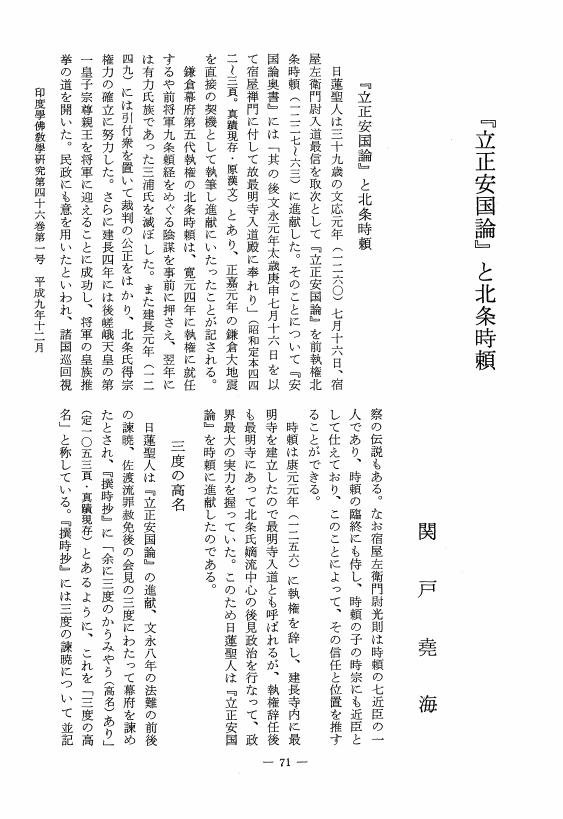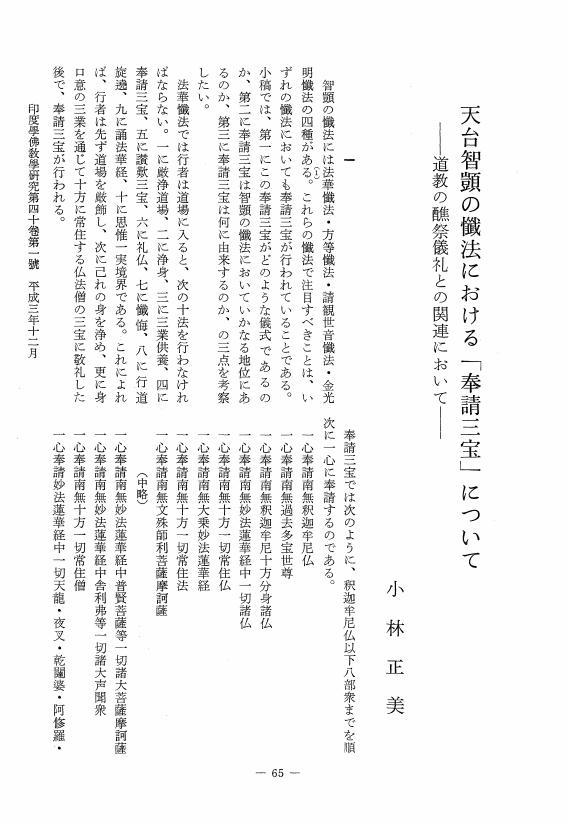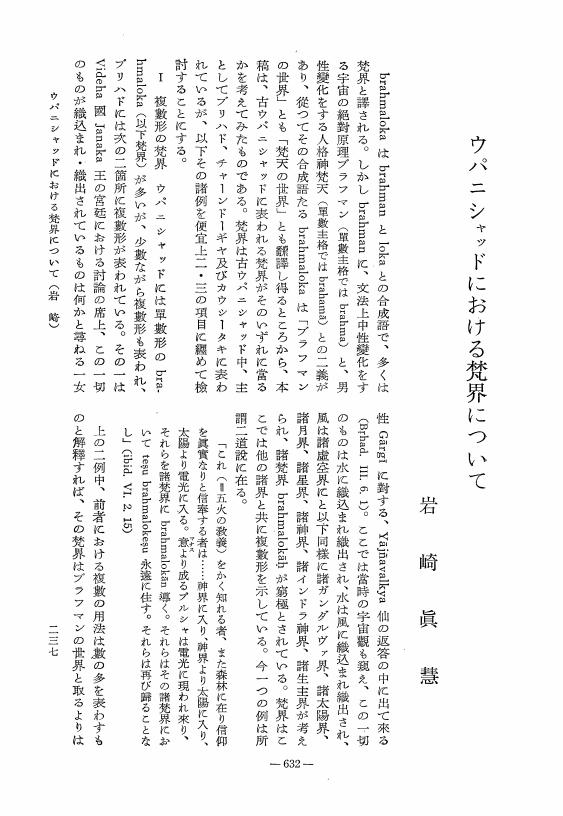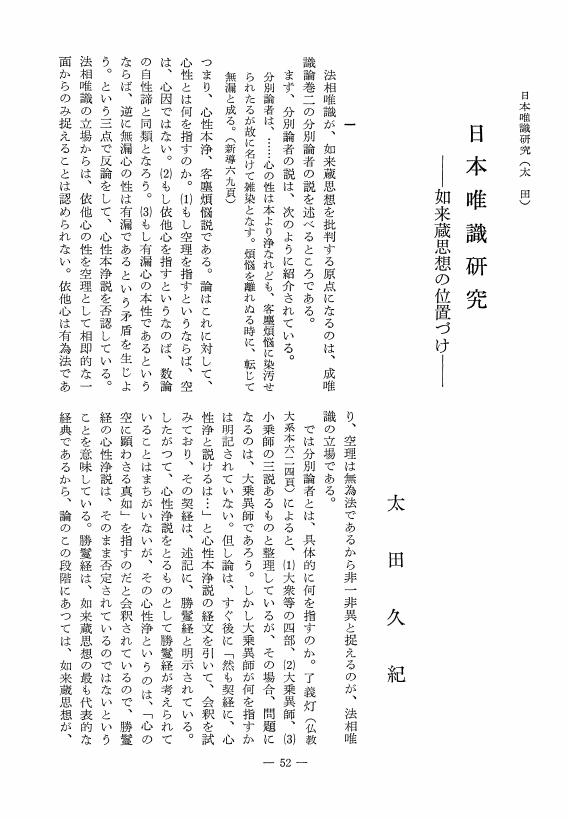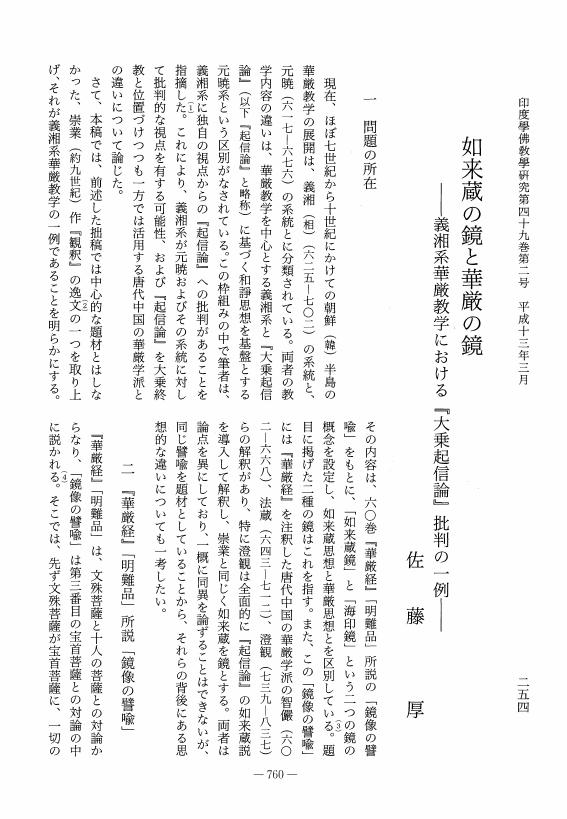1 0 0 0 OA チェーヤ・スッタの特質
- 著者
- 奥田 清明
- 出版者
- Japanese Association of Indian and Buddhist Studies
- 雑誌
- 印度學佛教學研究 (ISSN:00194344)
- 巻号頁・発行日
- vol.15, no.2, pp.667-671, 1967-03-31 (Released:2010-03-09)
1 0 0 0 OA チワンゴンパ spyi-dban-dgon-pa の仮面舞踊劇マニリンドゥについて
- 著者
- 佐々木 隆子
- 出版者
- Japanese Association of Indian and Buddhist Studies
- 雑誌
- 印度學佛教學研究 (ISSN:00194344)
- 巻号頁・発行日
- vol.29, no.2, pp.699-702, 1981-03-31 (Released:2010-03-09)
1 0 0 0 OA 『立正安国論』と北条時頼
- 著者
- 関戸 堯海
- 出版者
- Japanese Association of Indian and Buddhist Studies
- 雑誌
- 印度學佛教學研究 (ISSN:00194344)
- 巻号頁・発行日
- vol.46, no.1, pp.71-76, 1997-12-20 (Released:2010-03-09)
- 参考文献数
- 9
1 0 0 0 OA 選擇集新考
- 著者
- 福井 康順
- 出版者
- Japanese Association of Indian and Buddhist Studies
- 雑誌
- 印度學佛教學研究 (ISSN:00194344)
- 巻号頁・発行日
- vol.10, no.2, pp.405-419, 1962-03-31 (Released:2010-03-09)
1 0 0 0 OA 天台智〓の懺法における「奉請三宝」について -道教の〓祭儀礼との関連において-
- 著者
- 小林 正美
- 出版者
- Japanese Association of Indian and Buddhist Studies
- 雑誌
- 印度學佛教學研究 (ISSN:00194344)
- 巻号頁・発行日
- vol.40, no.1, pp.65-70, 1991-12-20 (Released:2010-03-09)
1 0 0 0 OA 江戸初期の排仏論
- 著者
- 高神 信也
- 出版者
- Japanese Association of Indian and Buddhist Studies
- 雑誌
- 印度學佛教學研究 (ISSN:00194344)
- 巻号頁・発行日
- vol.22, no.2, pp.799-802, 1974-03-31 (Released:2010-03-09)
1 0 0 0 OA FAS禅について
- 著者
- 藤吉 慈海
- 出版者
- Japanese Association of Indian and Buddhist Studies
- 雑誌
- 印度學佛教學研究 (ISSN:00194344)
- 巻号頁・発行日
- vol.25, no.1, pp.43-46, 1976-12-25 (Released:2010-03-09)
- 著者
- Gyana Ratna SRAMAN
- 出版者
- Japanese Association of Indian and Buddhist Studies
- 雑誌
- 印度學佛教學研究 (ISSN:00194344)
- 巻号頁・発行日
- vol.51, no.1, pp.477-474, 2002-12-20 (Released:2010-03-09)
- 被引用文献数
- 1 1
1 0 0 0 OA 本覚思想と神道理論
- 著者
- 田村 芳朗
- 出版者
- Japanese Association of Indian and Buddhist Studies
- 雑誌
- 印度學佛教學研究 (ISSN:00194344)
- 巻号頁・発行日
- vol.28, no.1, pp.61-68, 1979-12-31 (Released:2010-03-09)
1 0 0 0 OA 『十地経論』の六相解釈
- 著者
- 金 京南
- 出版者
- Japanese Association of Indian and Buddhist Studies
- 雑誌
- 印度學佛教學研究 (ISSN:00194344)
- 巻号頁・発行日
- vol.55, no.2, pp.945-942,1280, 2007-03-20 (Released:2010-07-01)
As is well-known, the Six Characteristics (六相), originating from the Dasabhumika-sutra (DBh), are used as the method of annotation in the DBhV. The purpose of this paper is to clarify the interpretation of the Six Characteristics in the DBhV, specifically focusing on the Fifth Characteristic (vivarta,成相) and the Sixth Characteristic (samvarta, 壊相)by comparing a Tibetan version with a Chinese version.We can find a transfiguration between the equivalent Tibetan and Chinese versions. That is, vivarta and samvarta are translated as 'du ba (to assemble) and rgyas pa (to spread) in the Tibetan version, whereas vivarta translates as evolution(成相) and samvarta translates as destruction (壊相)in the Chinese version. This transfiguration brings a difference in interpretation of vivarta and samvarta in commentaries of the DBhV. Furthermore, misinterpretations of vivarta and samvarta can be seen in current studies of the Six Characteristics due to a use of both versions but a lack of consideration regarding the aforementioned transfiguration.
1 0 0 0 OA 螺髪考
- 著者
- 金 炳悟
- 出版者
- Japanese Association of Indian and Buddhist Studies
- 雑誌
- 印度學佛教學研究 (ISSN:00194344)
- 巻号頁・発行日
- vol.38, no.1, pp.275-277, 1989-12-20 (Released:2010-03-09)
1 0 0 0 OA 律的側面からみた『文殊般若経』-大乗経典の経・律相即性-
- 著者
- 立花 弥生
- 出版者
- Japanese Association of Indian and Buddhist Studies
- 雑誌
- 印度學佛教學研究 (ISSN:00194344)
- 巻号頁・発行日
- vol.48, no.2, pp.1061-1059, 2000-03-20 (Released:2010-03-09)
1 0 0 0 OA ウパニシャッドにおける梵界について
- 著者
- 岩崎 眞慧
- 出版者
- Japanese Association of Indian and Buddhist Studies
- 雑誌
- 印度學佛教學研究 (ISSN:00194344)
- 巻号頁・発行日
- vol.7, no.2, pp.632-635, 1959-03-30 (Released:2010-03-09)
1 0 0 0 OA Empirical Intuition in Jaina Logic (III)
- 著者
- 長崎 法潤
- 出版者
- Japanese Association of Indian and Buddhist Studies
- 雑誌
- 印度學佛教學研究 (ISSN:00194344)
- 巻号頁・発行日
- vol.27, no.2, pp.941-936, 1979-03-31 (Released:2010-03-09)
1 0 0 0 OA 華厳家の止観に対する解釈
- 著者
- 陳 永裕(本覺)
- 出版者
- Japanese Association of Indian and Buddhist Studies
- 雑誌
- 印度學佛教學研究 (ISSN:00194344)
- 巻号頁・発行日
- vol.53, no.1, pp.309-303, 2004-12-20 (Released:2010-03-09)
1 0 0 0 OA 日本唯識研究 -如来蔵思想の位置づけ-
- 著者
- 太田 久紀
- 出版者
- Japanese Association of Indian and Buddhist Studies
- 雑誌
- 印度學佛教學研究 (ISSN:00194344)
- 巻号頁・発行日
- vol.29, no.1, pp.52-57, 1980-12-31 (Released:2010-03-09)
1 0 0 0 OA 如来蔵の鏡と華厳の鏡 -義湘系華厳教学における『大乗起信論』批判の一例-
- 著者
- 佐藤 厚
- 出版者
- Japanese Association of Indian and Buddhist Studies
- 雑誌
- 印度學佛教學研究 (ISSN:00194344)
- 巻号頁・発行日
- vol.49, no.2, pp.760-764, 2001-03-20 (Released:2010-03-09)
1 0 0 0 OA 法藏における一心の性格について
- 著者
- 鍵主 良敬
- 出版者
- Japanese Association of Indian and Buddhist Studies
- 雑誌
- 印度學佛教學研究 (ISSN:00194344)
- 巻号頁・発行日
- vol.13, no.2, pp.664-667, 1965-03-31 (Released:2010-03-09)
1 0 0 0 OA 法蔵の唯識説への対応
- 著者
- 石橋 真誡
- 出版者
- Japanese Association of Indian and Buddhist Studies
- 雑誌
- 印度學佛教學研究 (ISSN:00194344)
- 巻号頁・発行日
- vol.32, no.2, pp.954-957, 1984-03-25 (Released:2010-03-09)
1 0 0 0 OA 無我の実践について
- 著者
- 朴 京俊
- 出版者
- Japanese Association of Indian and Buddhist Studies
- 雑誌
- 印度學佛教學研究 (ISSN:00194344)
- 巻号頁・発行日
- vol.53, no.1, pp.394-390, 2004-12-20 (Released:2010-03-09)


